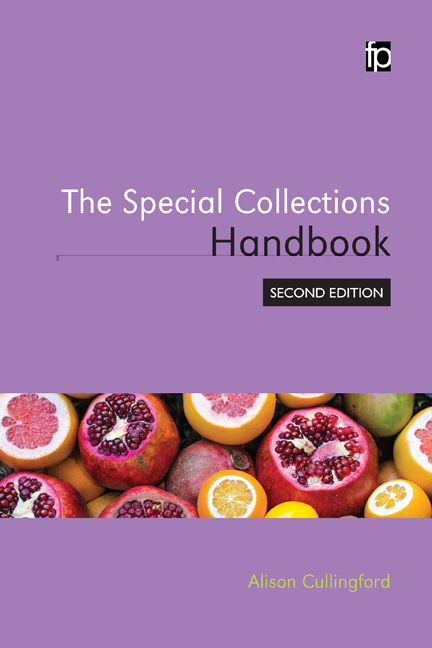Book contents
- Frontmatter
- Contents
- Preface and acknowledgements
- Introduction
- 1 The care of Special Collections
- 2 Emergency planning for Special Collections
- 3 Understanding objects in Special Collections
- 4 Acquiring and developing Special Collections
- 5 Cataloguing, description and metadata in Special Collections
- 6 Digitization and digital libraries in Special Collections
- 7 Legal and ethical issues in Special Collections
- 8 User services in Special Collections
- 9 Marketing and communications in Special Collections
- 10 Widening access to Special Collections
- 11 Organizational resources for Special Collections: space and people
- 12 Influencing and fund-raising for Special Collections
- Afterword: Special Collections futures
- Appendix A The Special Collections reference shelf
- Appendix B Skills for your Special Collections career
- Bibliography
- Index
10 - Widening access to Special Collections
- Frontmatter
- Contents
- Preface and acknowledgements
- Introduction
- 1 The care of Special Collections
- 2 Emergency planning for Special Collections
- 3 Understanding objects in Special Collections
- 4 Acquiring and developing Special Collections
- 5 Cataloguing, description and metadata in Special Collections
- 6 Digitization and digital libraries in Special Collections
- 7 Legal and ethical issues in Special Collections
- 8 User services in Special Collections
- 9 Marketing and communications in Special Collections
- 10 Widening access to Special Collections
- 11 Organizational resources for Special Collections: space and people
- 12 Influencing and fund-raising for Special Collections
- Afterword: Special Collections futures
- Appendix A The Special Collections reference shelf
- Appendix B Skills for your Special Collections career
- Bibliography
- Index
Summary
Introduction
This chapter looks at widening access to Special Collections beyond the standard services to traditional groups of users outlined in Chapter 8, reaching out to market Special Collections to new audiences. It should be seen in light of the ideas and techniques presented in Chapter 9. It will:
Explain why Special Collections are trying to widen access.
Discuss issues and obstacles in widening access.
Look in detail at Special Collections work with two groups of non-traditional users: undergraduates and school-age children.
Introduce other possibilities for widening access.
Widening access is often known as outreach. It is becoming more significant in Special Collections work: libraries are recognizing how valuable Special Collections can be in making their organization distinctive and helping with lifelong learning. Other terms associated with widening access are audience development, ‘identifying who you want to engage with your heritage project, and taking proactive steps to attract and retain their interest’ (Heritage Lottery Fund website, www.hlf.org.uk) and community engagement, in which universities and other organizations try to work more closely with local people.
Why build new audiences?
Special Collections often lack time and resources to manage existing readers, not to mention preservation problems, hidden collections and other pressures. The activities in this chapter are, as all commentators observe, highly labour-intensive. So why are librarians keen to reach out to new audiences?
A proactive way to develop service
The Special Collections world is changing, thanks to mass digitization of older texts. Librarians cannot assume that the same groups will continue to wish to access collections in the same way. Rather than watching traditional use decline, why not seek new audiences and explore new ways of using collections?
Advocacy
Chapter 12 explains that Special Collections must demonstrate their value to their institution by showing how they contribute to its mission:
Special Collections in universities can do this by emphasizing their work with students, increasingly central to their parent organization's mission.
Special Collections can offer any parent organization a way to reach beyond their walls into communities, thanks to their range of compelling materials and stories. Not forgetting, of course, that the more people who understand and appreciate Special Collections, the more support libraries will receive for their work in future.
- Type
- Chapter
- Information
- The Special Collections Handbook , pp. 193 - 214Publisher: FacetPrint publication year: 2016



